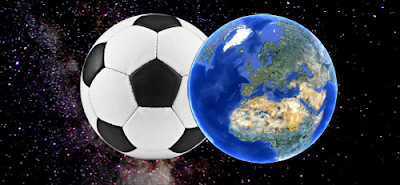Our Planet

Putting the Earth in perspective is nearly impossible with traditional diagrams. Most illustrations of our planet come with the disclaimer “Not to scale” – and for good reason.
The relative dimensions of Earth’s features are so extreme that they’re difficult to draw accurately. However, we can visualize the Earth in perspective using mental imagery and familiar comparisons. By understanding these true scales – from Earth’s paper-thin crust to our position in the universe – we gain a profound appreciation for our planet and our place in the cosmos. Let’s explore Earth’s dimensions using scale models you can picture in your mind..
Earth’s Physical Scale in Perspective
Imagine the globe 12 inches in diameter in the middle across the equator in front of you. That’s about football size (or soccer ball size for non UK folk). It will look spherical, although it is about 1/20th of an inch smaller from top to bottom (pole to pole).
You hear of continental drift, and plate tectonics, and find it difficult to imagine? The crust on your 12 inch earth is a 1/20th of an inch thick at the thickest point – in some places it’s less than 5 thousands of an inch.
A crust? That’s more like a surface scum! Underneath that is around 3 inches of surface mantle, its fairly solid, but plasticy so it can, and does move.
The atmosphere, where we all live becomes too thin to breath at one hundredth of an inch above the surface, this by the way is the height of Mount Everest. It continues up getting thinner and thinner to the dizzy heights of 1/10th of an inch, beyond which it is negligible.
The deepest part of the ocean plummets to 1/50th of an inch, but the average depth is only 3 thousands of an inch – our globe is only slightly damp.
An astronaut is defined as a person who has been more than 80km above the surface of the earth, on our globe that is about 1/15 of an inch. Felix Baumgartner’s space jump was about a millimeter
The moon is around 3 inches in diameter ( a bit like a tennis ball) and around 30 feet away.
The sun is 110 feet in diameter and its 2.2 miles away
The nearest star is 600,000 miles away.
A human being is about the size of a virus, the smallest living organism. Blue whales, the largest animals on the planet are the size of bacteria.
Life on Earth: A Timeline Perspective
Let’s do the same with time, and imagine that our earth formed a week ago.
The universe was created in the big bang two weeks ago.
Life appeared after only one day! (Yes the universe is only twice as old as life on earth
The next day photosynthesis began. This continued for a couple of days, but the living organisms which were photosynthesising put too much of there own waste products (oxygen) into this 1/100 inch thick atmosphere and they mostly died out.
But they were replaced by a combination of life, some of which used photosynthesis to live off carbon dioxide and gave off oxygen, and some of which used the oxygen to live, consumed other carbon rich life and gave off carbon dioxide – a rather neat symbiosis. This continues to this day.
Around eight and a half hours ago the dinosaurs appeared and disappeared quite suddenly about two hours and twenty minutes ago.
It’s sobering to think that they were the dominant species for almost 6 hours, especially considering the first humans appeared only 4 minutes ago.
Abraham walked the earth ½ second ago, Jesus ¼ second, and Mohammed 1/6 second.
Current thinking is that the temperature of the earth will increase by six degrees is the next 70 thousands of a second and as a result the earth will only be able to support one sixth of the current human population.
Our place in the Universe*
Now to put the Earth into the Universe. The Earth goes around our sun and this is one sun in a galaxy of 300 thousand million suns. The galaxy is called the milky way. It’s a disk shape, fatter in the middle a bit like a fried egg.
Let’s imagine we shrink the galaxy down to the 8000 miles (the real diameter of the earth). Our earth is close to the edge and its about the size of a flu virus.
The visible Universe is about 500,000 times the size of our own galaxy and contains about 170 thousand million galaxies.
Do you find this amazing? I do. But there is something I find even more amazing:-
Over the last few cosmic seconds on an infinitesimally small spec in the corner of one of billions of galaxies, a species has evolved that thinks they are the peak of the universe’s achievements!
They believe that the creator of the universe has visited this sub microscopic spec less than a cosmic second ago and passed secret knowledge onto them!
And they argue, fight, and kill each other over how to interpret the “Creator’s” words!
Now that’s amazing.
